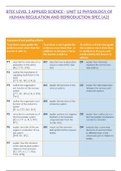BTEC LEVEL 3 APPLIED SCIENCE - UNIT 12 PHYSIOLOGY OF
HUMAN REGULATION AND REPRODUCTION SPEC (A2)
, UNIT 12 ASSIGNMENT 2
Nervous system and endocrine system
The Organisation of the Cells of the Nervous System
Nervous System .The nervous system is made up of two primary cells that are
Glial cells and neurons.
.Glial cells play a part in the physical and metabolic support of
Organisation of the Nervous System
nutrient transmission, insulin supply, and neural communication.
.The nervous system is and up of two main parts and these are
known as... .Neuron cells are made up of nerve cells and are specialized in
.CNS (Central Nervous System): The CNS is made up of the brain impulse transmission, and these impulses are distributed across
and spinal cord. the cell membrane.
.PNS (Peripheral Nervous System): The PNS is all the nerves . Ependymal cells: Ependymal, situated around the spinal
outside the nervous system.Furthermore, the PNS is an ventricular system,
automatic and somatic nervous system that also includes the of the brain and spinal cord. The ependymal is a thin lining that
majority of the body's nerve tissues. constitutes the cells and basal membranes located on the
.The Automatic Nervous System is involuntary, meaning that the astrocytes. They have a speci c function in
nerves respond unconsciously. The beating of the heart, breathing, producing cerebrospinal uid.
and blood ow are all performed without regulation, for example.
.Parasympathetic and Sympathetic nervous system: where the rest Generation of Action Potential
and digestive portion of the body are operated by the
parasympathetic nervous system, while the sympathetic nervous .The neurons are seen as more negative ions (K+ potassium) within
the more positive ions (sodium Na+) on the outside. There is a
system regulates the ght and ight nerves in the body. Somatic
disparity in quantity charges. Holding more positive ions outside the
nerves are voluntary, which implies that the reaction or activity of
cell than inside the cell is the way the resting potential is preserved.
the nerves is regulated.This happens when a nerve pathway binds
Essentially the number of sodium ions is greater than the sum of
to the spinal cord directly. Re ex arcs contain examples of:
potassium ions outside the cell.Without these the production of
Jerking your hand back after hitting a hot pan accidentally and action potential is not possible.
Unintentional jerking when your doctor clicks on your knee. .The cell membrane becomes more permeable to potassium ions
.The Somatic Nervous System is also the sensory tissue that and not sodium ions during the resting stage of the neuron. Via
consists of Sending impulses to the brain from sensory what is called the sodium potassium pump, sodium will reach the
nerves.The skin, eyes and ears are examples of these sensory cell.The scienti c term for a "pump" is a membrane-bound molecule
nerves. As-well as the tongue and mouth.The motor neurons that transfers ions in or out of a cell using the active transport
transmit brain impulses to the effectors mechanism.This is possible by using energy to vigorously pump
.The Nervous system diagram below clearly shows the three sodium out and two potassium out and that is why, relative to
the inside of the cell, there are more positive ions outside the cell
separation between the CNS and PNS.
membrane.
.The formation of a potential for action occurs when a neuron is
Rapidly depolarized, from a negative potential as a resting place to
a positive potential. The in ux of cations, which are the calcium
and sodium ions carried in the ion channels, accomplishes this
process.This procedure takes place inside the action potential
initiation zone
.1.) The stimulus in the action potential graph at the beginning
has a
fast alteration of the voltage. Upon hitting the clamp-patch The
current is administered to the cell mode, so the voltage is
increased above the threshold voltage, beginning a
depolarization of the membrane.
.2.) Since the membrane has a quick rise, depolarization is
triggered.This causes rapid increase, leading to the opening of





